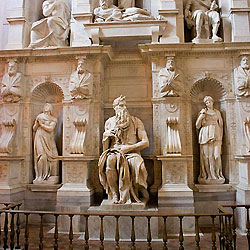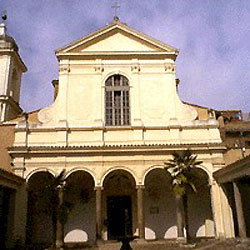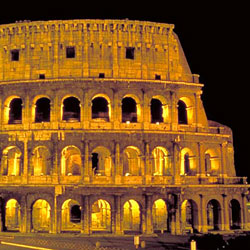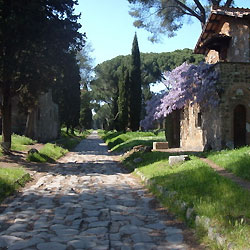Rome Tours
Monumental Rome | Archaeological | St. Peter Basilica, the Vatican and Sistine Chapel | Trevi Fountain, the Catacombs, Appian Way, Borghese Gallery
Monumental tour of Rome
The capital of Italy is probably the most visited city in the world. Whilst, arguably, for the Italians Rome is primarily the political centre of the nation, for others it is its wealth of architectural and artistic treasures which makes it a truly remarkable and unforgettable city. The numerous museums, monuments and churches, not to mention the archaeological sites, represent a cultural heritage so vast that a whole lifetime would not be sufficient to explore it in its entirety.
This is why if you visit the city of Rome...non basta una vita per visitarla, is not enough a life time to visit the Eternal City.
Suggested day tour of Rome with the visit of St. Peter in Chains, Basilica of St. Clemente-underground-Rome , the Coliseum, Arch of Constantine, the Capitol Hill, Catacombs of St. Sebastian, The Appian Way and Trevi Foutain, the service is driver/guided and is individually personalized.
Monumental Rome | Archaeological | St. Peter Basilica, the Vatican and Sistine Chapel | Trevi Fountain, the Catacombs, Appian Way, Borghese Gallery
Monumental tour of Rome
The capital of Italy is probably the most visited city in the world. Whilst, arguably, for the Italians Rome is primarily the political centre of the nation, for others it is its wealth of architectural and artistic treasures which makes it a truly remarkable and unforgettable city. The numerous museums, monuments and churches, not to mention the archaeological sites, represent a cultural heritage so vast that a whole lifetime would not be sufficient to explore it in its entirety.
This is why if you visit the city of Rome...non basta una vita per visitarla, is not enough a life time to visit the Eternal City.
Suggested day tour of Rome with the visit of St. Peter in Chains, Basilica of St. Clemente-underground-Rome , the Coliseum, Arch of Constantine, the Capitol Hill, Catacombs of St. Sebastian, The Appian Way and Trevi Foutain, the service is driver/guided and is individually personalized.
| Basilica of St. Peter in Chains. San Pietro in Vincoli (Saint Peter in Chains) is a small basilica in Rome, founded in the 5th century to house the reported chains that bound St. Peter in Jerusalem. Even more famous than the chains of Saint Peter is Michelangelo's statue Moses, part of the Tomb of Pope Julius II. The basilica was first built in the middle of the 5th century to house the relic of the chains that bound Saint Peter while imprisoned in Jerusalem. According to legend, when Empress Eudoxia (wife of Emperor Valentinian III) gave Pope Leo I the chains as a gift, he compared them to the chains of St. Peter's first imprisonment in the Mamertine Prison in Rome and the two chains miraculously fused together. The chains are kept in a reliquary under the main altar in the basilica. The basilica has undergone several restorations and rebuildings, including a restoration by Pope Adrian I, a rebuilding by Pope Sixtus IV and another by Pope Julius II. There was also a renovation in 1875. Some modernizations were made at that time. Michelangelo's Moses, which dates from 1515, is the most notable piece of artwork in the basilica. Originally intended as part of a 40-statue funeral monument for Pope Julius II, "Moses" became the Pope's funeral monument and tomb in his family's church. |
 |
| The Basilica of St. Clement. The Basilica of St. Clement was mentioned by St. Jerome in the 4th century, is one of the most interesting in Rome from an artistic and archaeological point of view. It was almost buried under the enormous quantity of debris accumulated in that zone after the terrible fire caused by the Normans in the 11th century, but was rebuilt in the 12th century by Paschal II on higher level. The new Basilica was built in the original form with all the architectural elements it was possible to save, so that it remains, in spite of restorations and modification of more recent date, a rare example of a typical early Christian basilica. To admire of this Basilica dated 12th century is the mosaics on the apse which, in a prodigious synthesis of Christian and pagan figurative elements, portray the Scene of the Redemption of Roman school, the Candelabra, the Schola Cantorum and more. There are notable works of art of the renaissance in this basilica, masterpieces of Masolino and Masaccio. During the excavations in the underground basilica of the 4th century, which took place in the 18th and 19th century was brougth to light by the archaeologist other Imperial and Republican constructions including a " Mithraeum", a grotto shaped room devoted to the worship of the Persian god Mithra. Mithraism, which was wide spread in the 3rd century in Rome, was a mystery religion with ritual similiar in some ways to that of Christianity. This place today is also of extraordinary interest to archaeologist. |
 |
| The Coliseum, Arch of Constantine and Capitol Hill. The Anfiteatro Flavio, known throughout the world, the Coliseum is symbolic of the city of Rome. It is 50 meters high, 86 meters long and 54 meters wide, distributed on a structure of elliptic form. It was built under the rule of the Emperor Vespasiano on an artificial lake in 79 A.D. The Coliseum was inaugurated by Tito and became the theatre of frighteningly cruel games, in which gladiators fought each other and lions were let loose on human beings who were destined to be mauled to death. In the lower part of the Coliseum one can see the underground passages and the tunnels where the lions were kept. The Coliseum was later used as a source of materials for building works. Near to the Coliseum one finds Costantino's Arch which has to be the best example of the "recycling" carried out during the crisis of the Massenzio Empire in 312 A.D. The Domus Area, once the residential quarters of Nerone which were built after the terrible fire of 64 A.D., is close by in the Colle Oppio Park.Piazza del Campidoglio originates from a design by the great Michelangelo Buonarroti, facing San Pietro, with an equestrian statue by Marco Aurelio at its center, transfered here in 1538 from the Laterano on the request of Pope Paolo III. In the Piazza del Campidoglio one finds Palazzo Senatorio, work of Giacomo Della Porta and Girolamo Rainaldi, in which Rome's County Council meets; Palazzo Nuovo, designed by the Rainaldi Brothers; Palazzo dei Conservatori, the construction of which was initiated by Michelangelo Buonarroti and completed by Giacomo Della Porta; the Pinacoteca Capitolina, which houses an impressive collection of paintings from the Middle Ages to the late XVIII century, including works by Titian, Veronese, Rubens, Caravaggio and Pietro da Cortona. Within the vicinity of Piazza del Campidoglio one can visit the medieval Church of St Maria in Aracoeli, the Fortuna Virile Temple, the Vesta Temple, the Church of St Maria in Cosmedin, the Church of St Sabina and the Church of St Alessio and Bonifacio. |
 |
| The Catacomb of St. Sebastian. The Catacombs of Rome are ancient catacombs, or underground burial places under or near Rome, of which there are at least forty, some discovered only in recent decades. Though most famous for Christian burials, they include pagan and Jewish burials, either in separate catacombs or mixed together. They began in the 2nd century, as much as a response to overcrowding and shortage of land as they were to satisfy the need for persecuted Christians to bury their dead secretly. The soft volcanic tofo rock under Rome is highly suitable for tunnelling, as it is softer when first exposed to air, hardening afterwards. Many have kilometers of tunnels, in up to four stories (or layers). The Catholic catacombs are extremely important for the art history of early Christian art, as they contain the great majority of examples from before about 400 CE, in frescos andbig church was built in the 4th century. The tunnels here, if stretched out, would reach a length of 11km (6 2/3 miles). In the tunnels and mausoleums are mosaics and graffiti, along with many other pagan and Christian objects from centuries even before the time of Constantine. Though the catacombs themselves are fascinating, the tour here sculture. The Jewish catacombs are similarly important for the study of Jewish art at this period. To visit is the Catacomb of St, Sebastian, which the tomb of St. Sebastian is in the basilica, but his original resting place was in the catacombs underneath it. From the reign of Valerian to the reign of Constantine, the bodies of St, Peter and St, Paul were hidden in the catacombs, which were dug from tufa, a soft volcanic rock. The is one of the shortest and least satisfying of all the catacomb visits. |
 |
| The Appian Way. The Appian Way (Via Appia) was one of the earliest and strategically most important Roman roads of the ancient republic. It connected Rome to Brindisi, Apulia, in southeast Italy. Its importance is indicated by its common name, recorded by Statius. Appia teritur regina longarum viarum "the Appian way is commonly said to be the queen of the long roads". The road is named after Appio Cludio Cieco, the Roman censor who began and completed the first section as a military road to the south in 312 BC during the Samnite Wars. The main part of the Appian Way was started and finished in 312 BC. The road began as a leveled dirt road upon which small stones and mortar were laid. Upon this gravel was laid, which was finally topped with tight fitting, and interlocking stones to provide a flat surface. Some of the stones were said to fit so well that you could not slide a knife into the cracks.The road was crested in the middle (for water runoff) and had ditches on either side of the road which were protected by retaining walls. The road began in the Roman Forum, passed through the Servian Wall at the porta capena, went through a cutting in the clivus Martis, and left the city. For this stretch of the road, the builders used the via Latina.The building of the Aurelian Wall centuries later required the placing of another gate, the Porta Appia. Outside of Rome the new via Appia went through well-to-do suburbs along the via Norba, the ancient track to the Albans hills ( Today Albano), where Norba was situated. The road at the time was a via glarea, a gravel road. The Romans built a high-quality road, with layers of cemented stone over a layer of small stones, crowned, drainage ditches on either side, low retaining walls on sunken portions, and dirt pathways for sidewalks. The via Appia is believed to have been the first Roman road to feature the use of lime cement. The materials were volcanic rock. The surface was said to have been so smooth that you could not distinguish the joints. The Roman section still exists and is lined with monuments of all periods, although the cement has eroded out of the joints, leaving a very rough surface. |
 |